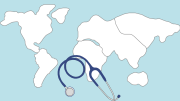New data from the Herschel Space Observatory shows massive reservoirs of ice near the young star TW Hydrae. The ice, if it were in liquid form, would fill “thousands of Earth oceans,” according to Michiel Hogerheijde, an astronomer at Leiden Observatory in the Netherlands and lead author of a paper in the journal Science describing the observations.
At five to 10 million years old, TW Hydrae is a young star. It’s only 176 light-years away from Earth, a short trip in astronomical terms. Scientists have known for a long time that it was surrounded by a protoplanetary disk — a cloud of dust and gas that may eventually condense into planets. They even discovered warm water vapour in the hot inner regions of the disk.
This is the first time anyone has detected cold vapour in the comet-forming region further out from the centre of the star. It is believed that in our solar system water frozen onto dust grains condensed into comets, which collided with a young, not-yet-formed Earth, providing an abundant source of water that eventually became our oceans. Herschel’s latest observation shows the early stages of this process.
The Herschel observatory, named after Sir Frederick William Herschel — the German-born British astronomer who discovered Uranus — is the largest astronomical telescope ever launched. It was built by the European Space Agency at a cost of 1.1 billion euros, and sent into space in 2009 with a mission to study the formation of stars and galaxies. One of its major scientific instruments is HIFI, the Heterodyne Instrument for the Far Infrared, a high-resolution spectrometer.
HIFI was the instrument used to collect data on TW Hydrae. It can see through gas and dust, deep into the heart of star-forming regions of space, and determine the chemical makeup of infrared sources at these immense distances. Ultraviolet light from TW Hydrae causes water molecules to break free of the ice in the protoplanetary disk. This leaves a thin layer of water vapour, whose light signature is detectable by the HIFI. The team detected 7.3 x 1024 grams of vapour. They plugged this number into statistical models based on previous observations and came out with an estimate of 9.0 x 1027 grams of ice hidden beneath the surface. This is equivalent to more than six thousand times the mass of all the water on Earth.
The two types of water molecules, ortho and para, emit slightly different colours in the infrared spectrum. Hogerheijde’s team used the HIFI to detect the emissions from both types of molecules and derived the ratio of orthowater to parawater. With this ratio, they were able to calculate a temperature of 13.5 Kelvin, or about -260 C.
So far, these are the most sensitive observations made using HIFI, according to Paul Goldsmith, a NASA scientist for the Herschel observatory.
“It is a testament to the instrument builders that such weak signals can be detected,” he said. These findings are another step forward in Herschel’s mission to discover how planets, stars and galaxies are formed.
“Here we are studying the ‘raw material’ for planet formation, which is fundamental to an understanding of how planetary systems such as our own solar system once formed,” said Göran Pilbratt, a scientist with the Herschel project.
Herschel is already scheduled to study similar regions around three other stars.



